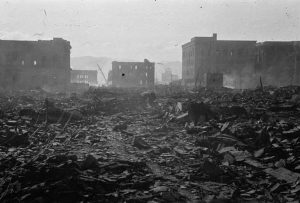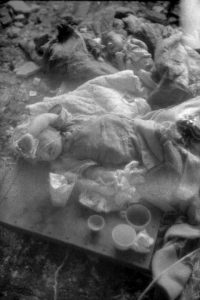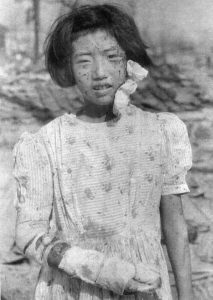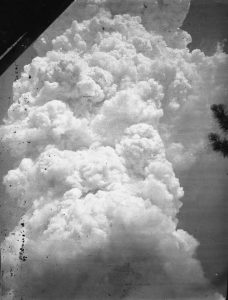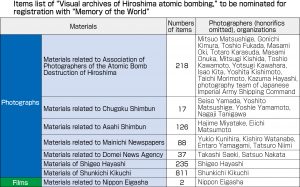Scenes of A-bombing tragedy communicated to present day: Hondori shopping street on day after bombing, wounded children, rising mushroom cloud
Nov. 29, 2023
by Kyosuke Mizukawa, Senior Staff Writer
The “Visual archives of Hiroshima atomic bombing—Photographs and films in 1945” — to be nominated for the “Memory of the World” register of the United Nations Educational, Scientific and Cultural Organization (UNESCO) — is an important historical record of A-bomb survivors and the city made up of photos and films that could only have been captured at the time by survivors, the news media, and survey team photographers on site at the horrific scene of the tragedy. The collection of 1,532 photographs and two films, including images of the city in the immediate aftermath, wounded children, and people suffering from radiation exposure, tell the story of the atomic bombing to our present day.
The photos were taken by 27 individuals and one organization. The late Toshio Fukada experienced the atomic bombing around 2.7 kilometers from the hypocenter and took shots of the mushroom cloud rising before his eyes. Mr. Fukada later became a member of the Association of Photographers of the Atomic Bomb Destruction of Hiroshima, an organization formed in 1978. The late Mitsugi Kishida captured the city center on film the day after it was destroyed in the atomic bombing.
Photographers from the Osaka head offices of the Asahi Shimbun and the Mainichi Newspapers entered Hiroshima on August 9, 1945, photographing the city center after its annihilation and severely burned survivors. The late Shunkichi Kikuchi accompanied an academic survey team in October of that year and traveled to different locations in Hiroshima. His photos include images of citizens who had lost their hair from the effects of radiation and scenes at relief stations.
The two films were shot by Nippon Eigasha (Japan Movie Co.), a company that produced news footage during the war. One film, Nihon News #257: “Atomic Bomb—The Disastrous Damage of Hiroshima” (2 min. 50 sec.), released on September 22, 1945, includes footage taken on September 3. That is the earliest Japanese news footage known to exist of the atomic bombing of Hiroshima. The film is owned by the Japan Broadcasting Corporation (NHK).
The other film was shot by staff with the survey team that Mr. Kikuchi was accompanying. The 110-minute film documents images of damage to the city as well as of A-bomb survivors. The film is owned by the National Film Archive of Japan’s Sagamihara Conservation Center; RCC Broadcasting collaborated in preserving the film and continued to report on related stories.
Many of the materials are available to the public at the Hiroshima Peace Memorial Museum, located in the city’s centrally located Naka Ward, on the websites of the news media organizations mentioned above, and elsewhere.
(Originally published on November 29, 2023)
The “Visual archives of Hiroshima atomic bombing—Photographs and films in 1945” — to be nominated for the “Memory of the World” register of the United Nations Educational, Scientific and Cultural Organization (UNESCO) — is an important historical record of A-bomb survivors and the city made up of photos and films that could only have been captured at the time by survivors, the news media, and survey team photographers on site at the horrific scene of the tragedy. The collection of 1,532 photographs and two films, including images of the city in the immediate aftermath, wounded children, and people suffering from radiation exposure, tell the story of the atomic bombing to our present day.
The photos were taken by 27 individuals and one organization. The late Toshio Fukada experienced the atomic bombing around 2.7 kilometers from the hypocenter and took shots of the mushroom cloud rising before his eyes. Mr. Fukada later became a member of the Association of Photographers of the Atomic Bomb Destruction of Hiroshima, an organization formed in 1978. The late Mitsugi Kishida captured the city center on film the day after it was destroyed in the atomic bombing.
Photographers from the Osaka head offices of the Asahi Shimbun and the Mainichi Newspapers entered Hiroshima on August 9, 1945, photographing the city center after its annihilation and severely burned survivors. The late Shunkichi Kikuchi accompanied an academic survey team in October of that year and traveled to different locations in Hiroshima. His photos include images of citizens who had lost their hair from the effects of radiation and scenes at relief stations.
The two films were shot by Nippon Eigasha (Japan Movie Co.), a company that produced news footage during the war. One film, Nihon News #257: “Atomic Bomb—The Disastrous Damage of Hiroshima” (2 min. 50 sec.), released on September 22, 1945, includes footage taken on September 3. That is the earliest Japanese news footage known to exist of the atomic bombing of Hiroshima. The film is owned by the Japan Broadcasting Corporation (NHK).
The other film was shot by staff with the survey team that Mr. Kikuchi was accompanying. The 110-minute film documents images of damage to the city as well as of A-bomb survivors. The film is owned by the National Film Archive of Japan’s Sagamihara Conservation Center; RCC Broadcasting collaborated in preserving the film and continued to report on related stories.
Many of the materials are available to the public at the Hiroshima Peace Memorial Museum, located in the city’s centrally located Naka Ward, on the websites of the news media organizations mentioned above, and elsewhere.
(Originally published on November 29, 2023)

